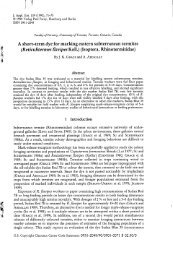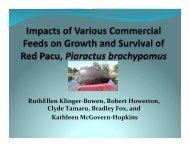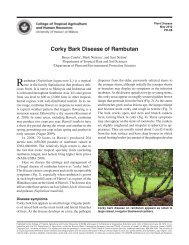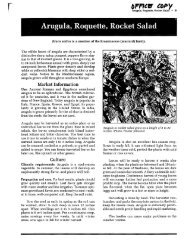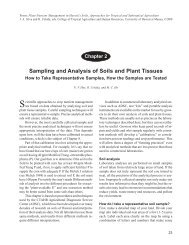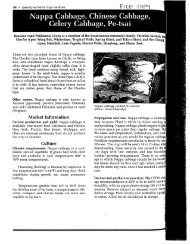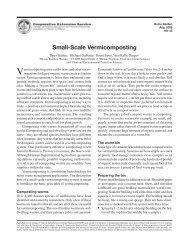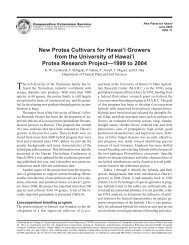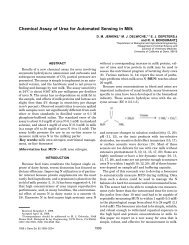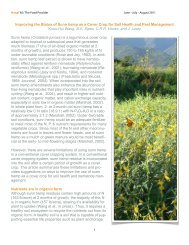Macadamia Nuts in Hawaii: History and Production - ctahr ...
Macadamia Nuts in Hawaii: History and Production - ctahr ...
Macadamia Nuts in Hawaii: History and Production - ctahr ...
You also want an ePaper? Increase the reach of your titles
YUMPU automatically turns print PDFs into web optimized ePapers that Google loves.
Figure 63. The use of bolts to save an embedded-bark limb, practiced<br />
by Ralph Moltzau <strong>in</strong> the 1930s.<br />
(Courtl'SY of Ralph 1-1. Molt,.au)<br />
canopy of small branches.<br />
To susta<strong>in</strong> yield by prun<strong>in</strong>g, when necessary,<br />
limbs or large branches should be pruned <strong>and</strong><br />
elim<strong>in</strong>ated at the po<strong>in</strong>t of their attachment to<br />
another branch to permit more light to go through<br />
the void thus created. In this manner the rema<strong>in</strong><strong>in</strong>g<br />
older branches will set flowers <strong>and</strong> thus<br />
<strong>in</strong>crease yield. This system of branch prun<strong>in</strong>g<br />
will also extend yield by forc<strong>in</strong>g top growth <strong>in</strong><br />
the proper direction <strong>and</strong> will enable trees to ma<strong>in</strong>ta<strong>in</strong><br />
total productivity over a longer period of time<br />
by better utilization of airspace.<br />
Fertilization<br />
Fertility requirements of macadamia have been<br />
studied <strong>and</strong> reported over the years by Cooil <strong>and</strong><br />
his co-workers (9, 10, 11), Shigeura et a1. (69, 70,<br />
72, 74), <strong>and</strong> Warner <strong>and</strong> Fox (86), suggest<strong>in</strong>g leaf<br />
analyses values that can be used <strong>in</strong> a more objective<br />
fertilization program. Cooil <strong>and</strong> his coworkers,<br />
work<strong>in</strong>g on M. <strong>in</strong>tegrifolia at Keaau<br />
Orchard on the isl<strong>and</strong> of <strong>Hawaii</strong> <strong>in</strong> the early 1950s,<br />
established leaf analyses values for nitrogen (N),<br />
phosphorus (P), potassium (K), <strong>and</strong> magnesium<br />
(Mg) us<strong>in</strong>g leaves at the time the major flush of<br />
growth is beg<strong>in</strong>n<strong>in</strong>g, generally <strong>in</strong> March. In this<br />
sampl<strong>in</strong>g procedure, a mature leaf is taken from<br />
the second whorl below the newly emerg<strong>in</strong>g flush.<br />
A total of 10 leaves is suggested for each sample.<br />
Cooil's values for ,P, K, <strong>and</strong> Mg have been found<br />
to be accura te <strong>and</strong> useful <strong>in</strong> predict<strong>in</strong>g nutritional<br />
needs of trees grow<strong>in</strong>g on the many soil types<br />
found <strong>in</strong> the state. This sampl<strong>in</strong>g procedure has<br />
now been extended <strong>and</strong> applied to leaf sampl<strong>in</strong>g<br />
throughout the year.<br />
Shigeura et aI., us<strong>in</strong>g Cooil's leaf val ues,<br />
developed a system us<strong>in</strong>g the leaves from the most<br />
recently matured term<strong>in</strong>al, which is dist<strong>in</strong>ct <strong>and</strong><br />
identifiable s<strong>in</strong>ce new term<strong>in</strong>als cont<strong>in</strong>ue to<br />
develop on macadamia throughout the year, <strong>and</strong><br />
the new leaves are glossier green than older leaves.<br />
The overrid<strong>in</strong>g advantage of us<strong>in</strong>g recently matured<br />
term<strong>in</strong>als is that the sampled leaves will be<br />
of the same vegetative age irrespective of the time<br />
of sampl<strong>in</strong>g, <strong>and</strong> represent the nutritional status<br />
of the tree at that time. Values thus obta<strong>in</strong>ed can<br />
be reasonably compared with leaves sampled at<br />
any time dur<strong>in</strong>g the year. On the other h<strong>and</strong>, the<br />
age of leaves <strong>in</strong> Cooil's method cannot be accurately<br />
determ<strong>in</strong>ed s<strong>in</strong>ce the leaves may be of recent<br />
orig<strong>in</strong> or may be more than a year old at sampl<strong>in</strong>g<br />
time. Consequently, leaf calcium (Ca) values on<br />
Cooil's "prior to fl ush<strong>in</strong>g" samples are erratic <strong>and</strong><br />
seem to be affected by the difference <strong>in</strong> the age of<br />
leaves. Cooil's difficulty <strong>in</strong> determ<strong>in</strong><strong>in</strong>g a critical<br />
leaf Ca value lends support to this statement.<br />
Fortunately, the value differences <strong>in</strong> N, P, K,<br />
<strong>and</strong> Mg between "March sampl<strong>in</strong>g" <strong>and</strong> "recently<br />
matured term<strong>in</strong>al" sampl<strong>in</strong>gs are not discernible.<br />
Calcium, however, differs very strongly. Data<br />
gathered by Shigeura et al. (72) <strong>in</strong> Kohala,<br />
<strong>Hawaii</strong>, suggest that leaf phosphate can be 0.07<br />
percent to 0.08 percent (Cooil, 0.08 percent) to<br />
obta<strong>in</strong> maximum nut quality (Fig. 64) <strong>and</strong> yield<br />
(Fig. 65). The difference <strong>in</strong> P noted here is hardl y<br />
anyth<strong>in</strong>g <strong>and</strong> not important by itself; but it should<br />
be monitored closely because phosphate approach<strong>in</strong>g<br />
0.10 percent <strong>in</strong> leaves becomes a problem,<br />
s<strong>in</strong>ce high leaf P <strong>in</strong>dicates an accumulation of<br />
phosphate <strong>in</strong> the substrate as soluble phosphate.<br />
Jones et al. (28) report work done with the electron<br />
microprobe show<strong>in</strong>g that there is actually a depletion<br />
of iron (Fe) <strong>and</strong> an accumulation of P <strong>in</strong> the<br />
vic<strong>in</strong>ity of the roots on Fe-chlorotic trees grow<strong>in</strong>g<br />
on aa lava l<strong>and</strong>. Shigeura et a1. (70) showed tha t<br />
under this condition the strong, healthy leaves at<br />
the very term<strong>in</strong>als of branches will beg<strong>in</strong> to yellow<br />
49



